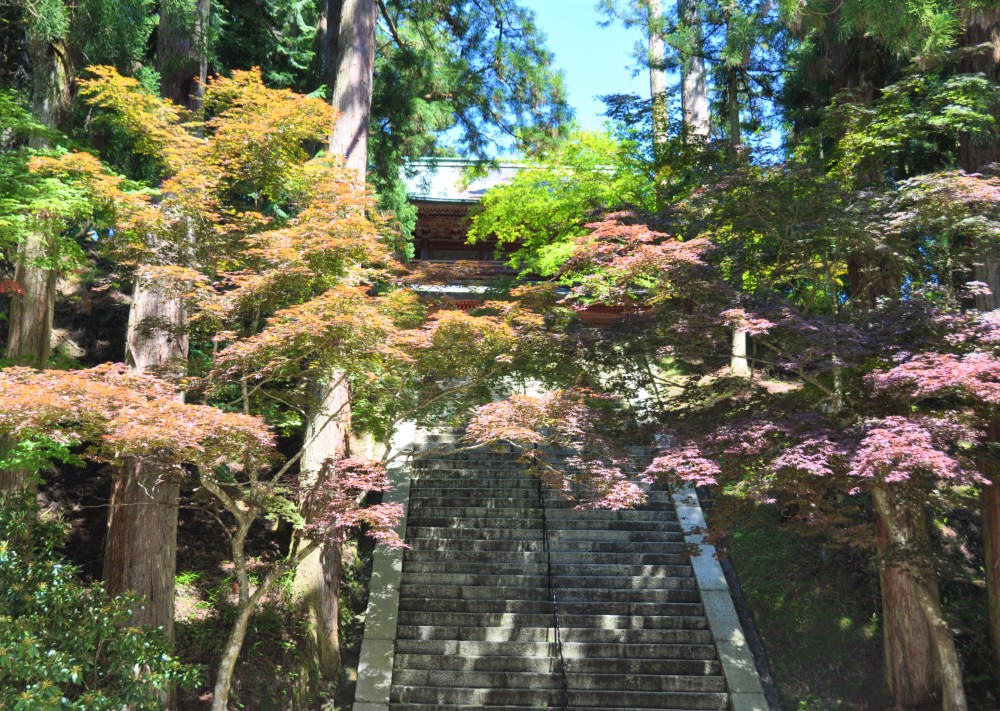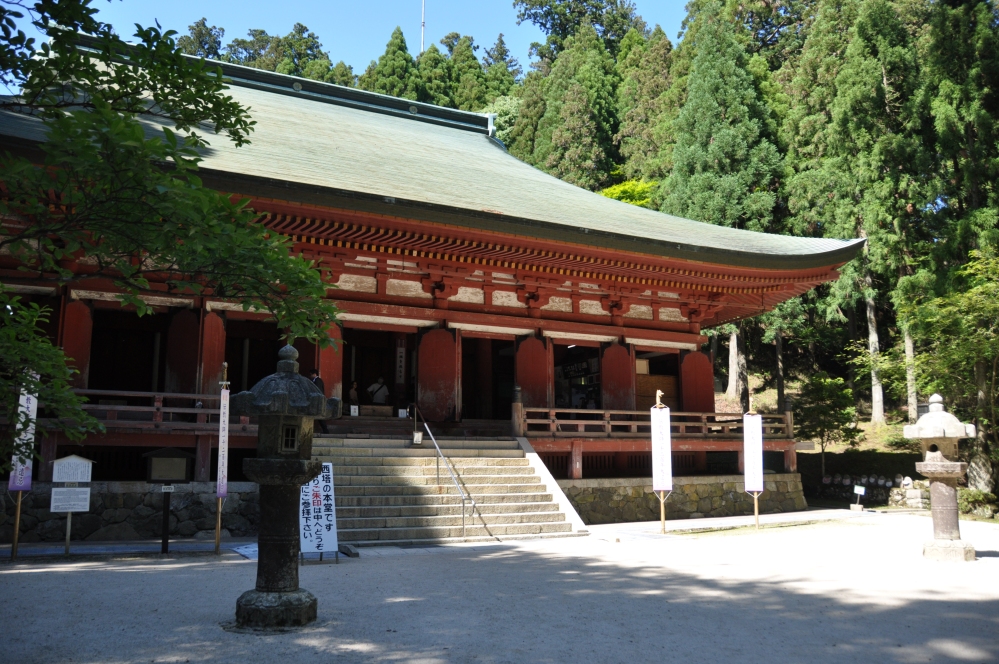Hey Everyone! I hope you are continuing to press on during this crazy year.
皆さまこんにちは。予断を許さない状況が続いておりますが、元気にお過ごしでしょうか。

Location
One of the biggest and most famous attractions in Otsu is the World Cultural Heritage Site, Hieizan Enryakuji Temple. Despite often erroneously claimed otherwise, THIS TEMPLE IS NOT IN KYOTO. I won’t put any specific blogs under fire for making this mistake, but I would like to clearly state that Hieizan Enryakuji Temple is, in fact, located in Otsu, Shiga Prefecture, not Kyoto (aside from a very small portion of the mountain.)
大津市の最も大きく、有名な観光スポットの一つは、ユネスコ世界文化遺産である比叡山延暦寺です。(ウェブで間違って書かれることが多いですが、比叡山のごく一部を除き、このお寺は京都ではなく、完全に大津市に位置しています。)
History (歴史 / 成り立ち)
 Hieizan Enryakuji Temple was founded in the year A.D. 788 by the Buddhist monk Saicho, a.k.a. Dengyo Daishi. Saicho, after studying Buddhism in China, returned to Japan and founded Enryakuji Temple on Mt. Hiei, which eventually grew into a huge temple complex of over 3,000 temple structures throughout the mountains. This temple is known both as the head of the Tendai sect of Buddhism, as well as the birthplace of Japanese Buddhism.
Hieizan Enryakuji Temple was founded in the year A.D. 788 by the Buddhist monk Saicho, a.k.a. Dengyo Daishi. Saicho, after studying Buddhism in China, returned to Japan and founded Enryakuji Temple on Mt. Hiei, which eventually grew into a huge temple complex of over 3,000 temple structures throughout the mountains. This temple is known both as the head of the Tendai sect of Buddhism, as well as the birthplace of Japanese Buddhism.
比叡山延暦寺は788年に最澄(伝教大師)により開かれました。最澄が数年間、中国で仏教を学んだのち日本へ戻り、比叡山に開いた延暦寺は、一時期3000以上の党塔を持つほどのお寺になりました。このお寺は天台宗の発祥の地であり、「日本仏教の母山」とも称されています。
In 1571 A.D. Oda Nobunaga, in an effort to preemptively prevent the power of the warrior monks to exceed his own, attacked and burned down the entirety of the temple, with the exception of the small, out of the way building, Ruri-do (Lapis Lazuli Hall). The Eternal Flame of Buddhism survived Oda Nobunaga’s attack because some of its flames were also lit in separate locations, enabling the flame to be re-lit back at its origin of Enryakuji Temple. Because of this destruction, all of the temple, with the exception of Ruri-do, was rebuilt, and dates back to the early Edo Period.
1571年、織田信長は延暦寺の僧侶に対する先制攻撃のため、寺院全体に火を放ちました。少し離れた瑠璃堂だけが焼け残りました。不滅の法灯は織田信長の焼け打ちでいったん消えてしまいましたが、別の場所に分灯されていたため、延暦寺の法灯に再び火を灯すことができました。この事件で、瑠璃堂を除き、比叡山延暦寺全体の再建が必要となり、現在見られる様子は江戸時代初期の姿です。


Mt. Hiei itself stands at a height of 848 meters; a relatively doable distance even for beginner hikers.
The specific trail we took is relatively old however, so there were definitely a few places in the trail eroded away by time.
It is definitely necessary to watch your step as you go.
比叡山は848メートルの高さで、山登り初心者にとっても、比較的挑戦しやすい高さの山です。今回私たち登った山道は結構古く、侵食されている箇所が幾つかあったので、登る際は必ず足元にご注意ください。
Layout (境内)

Modern day Enryakuji Temple consists of three main areas; To-do (east pagoda), Sai-tou (west pagoda) and Yokawa. The main attraction in the To-do is the Konpon Chu-do, or main hall of the entire temple complex. This hall houses the Eternal Flame of Buddhism, (不滅の法灯)which is said to have survived from the founding of the temple until the present day.
現代の延暦寺は東塔、西塔、そして横川という三つを中心とする区域で構成されています。東塔の中心は根本中堂の中で、お寺の開創から続く「不滅の法灯」が保管されています。

As of writing this blog, the Konpon Chudo is currently roughly 5 years into a 10 year construction, which is scheduled to be completed in the year 2026. Because of this, the Konpon Chudo cannot currently be seen from the outside as it is encased within a temporary structure, but the inside of the building remains open to visitors.
この記事の執筆時、根本中堂の大改修が始まってから5年ほど経ちました。大改修は開始から約10年の、2026年に完了する見込みです。この理由で今は根本中堂の外観を見ることはできませんが、中堂の内側は一般に公開されています。
Roughly a 20 min. walk from the To-do is the Sai-to, which features the Shaka-do and Ninai-do Halls. The Ninai-do is structured in a way to simulate the warrior monk Benkei, who was said to have been so strong that he carried the halls on his shoulders. Yokawa is located at a bit more of a distance from the other two areas, but if you are not in the mood for the approx. 4 km hike, buses are also available.
東堂から西塔まで徒歩約20分のところには、釈迦堂やにない堂があります。にない堂はかの有名な僧侶の弁慶が建物を担ぐ形を模した造りになっています。横川は東堂と西塔からもっと離れていますが、4キロも歩きたくない方はバスに乗ることも可能です。

Houses the Shaka Nyorai Buddha. The main hall of the 西塔.
釈迦如来が保管されている釈迦堂。西塔の本堂。

Temple Hall that is said to have been carried on the shoulders of Enryakuji’s great warrior monk, Benkei.
延暦寺の、弁慶という僧侶が両堂を肩に担いだという伝説から、「にない堂」と呼ばれています。

The mausoleum for Saicho. Tendai Buddhism teaches that Saicho still lives to this day in this building.
最澄の御廟のある場所。天台宗の教えでは、最澄が現在もここに生きていると言われています。
Hiking Trails & Public transportation (ハイキングコースと公共交通機関)
From Shiga:
-Hiking
The hiking trail we took starts at the stone staircase just to the left of the main torii gate of Hiyoshi Taisha Shrine. See here:
http://www43.tok2.com/home/kyotowalk/english_room/yama_kyoto/guide/mt_hiei/mp_hiei.html
for a map of other hiking trails on both the Shiga and Kyoto sides of the mountain.
滋賀県側:
・トレッキング
今回私たちが登った山道は日吉大社のすぐ左の階段からスタートです。そのほかのハイキングコース情報はこちらでご確認ください。http://www43.tok2.com/home/kyotowalk/english_room/yama_kyoto/guide/mt_hiei/mp_hiei.html
If you are not a hiker, fear not, for there are public transportation options on both the Kyoto side and Shiga side of the mountain. The Hieizan Sakamoto Cable Car is the longest cable car in Japan, and will take you from the bottom to the top of the mountain, or vice versa, in only 11 minutes.
交通機関をご利用になりたい方は、滋賀からも京都からもアクセスが可能です。比叡山坂本ケーブルは日本で一番長く、麓から延暦寺までたったの11分で行くことができます。
-Hieizan Sakamoto Cable Car
-approx. 10 min. walk from Keihan Sakamoto Hieizan-guchi Station
-approx. 20 min. walk from JR Hieizan Sakamoto Station
-Kojaku bus from JR Hieizan Sakamoto Station to Hieizan Sakamoto Cable
・ケーブル坂本
京阪坂本比叡山口駅から徒歩10分程度
JR比叡山坂本駅から徒歩20分程度
江若バスに乗り、JR比叡山坂本駅発、ケーブル坂本駅まで


From Kyoto:
-Hiking trail
From Kyoto’s Shugakuin Station on the Eizan line, walk about 15 min. along the canal to the beginning of the trail.
-Bus
The Keihan Hieizan Drive bus departing from Kyoto Station, get off at the Enryakuji Bus Center.
-Cable Car & Ropeway
Eizan Cable Car, departing from Yase-Hieizanhuchi Station. Transfer to the ropeway to get to the top.
Check out the video of Émilie and I as we climb Mt. Hiei and explore the temple grounds!
Also, despite what you may see online, this temple is still not in Kyoto.
私とエミリーの比叡山アドベンチャーについての動画をぜひご覧ください!
ちなみに、改めて言いますが、このお寺は京都にはありません。





